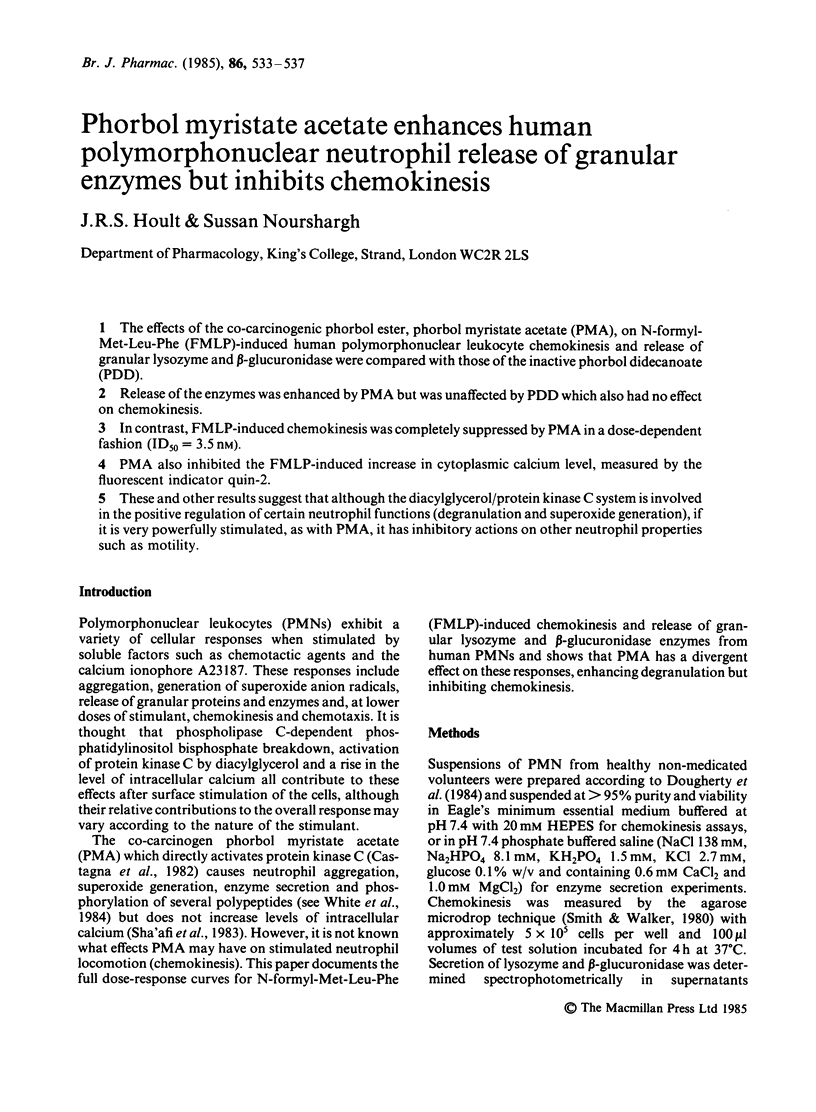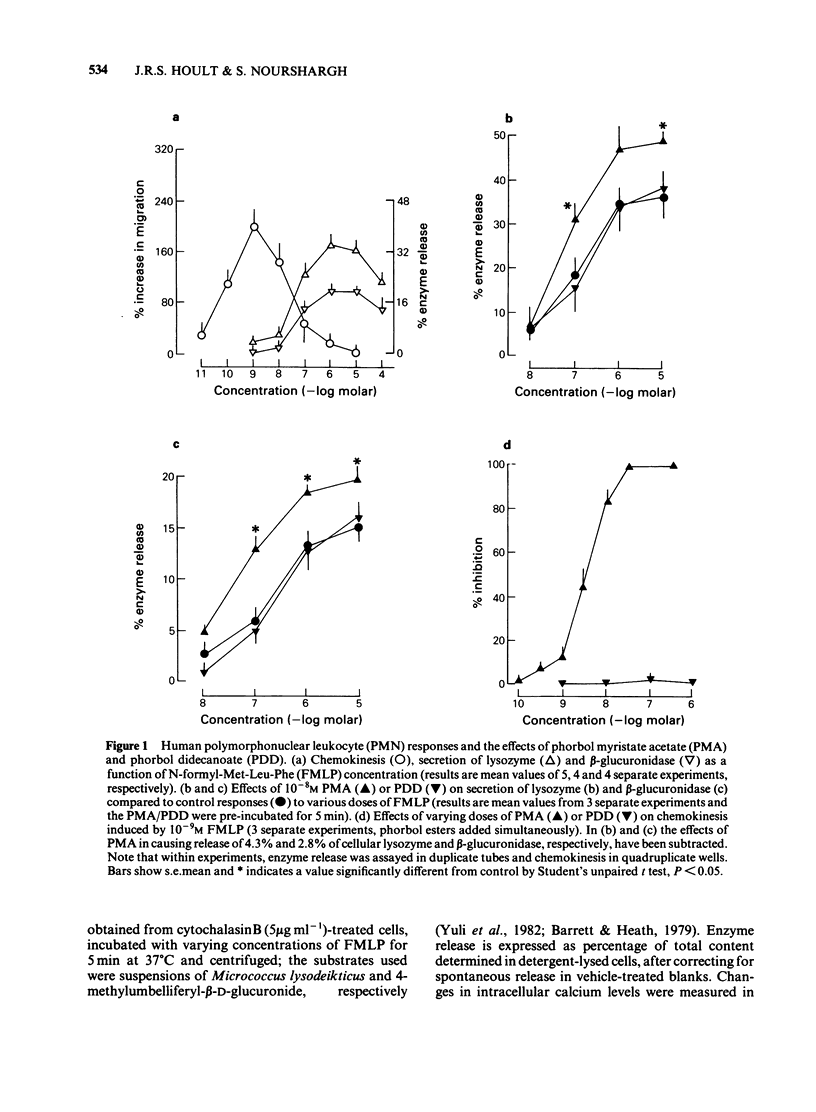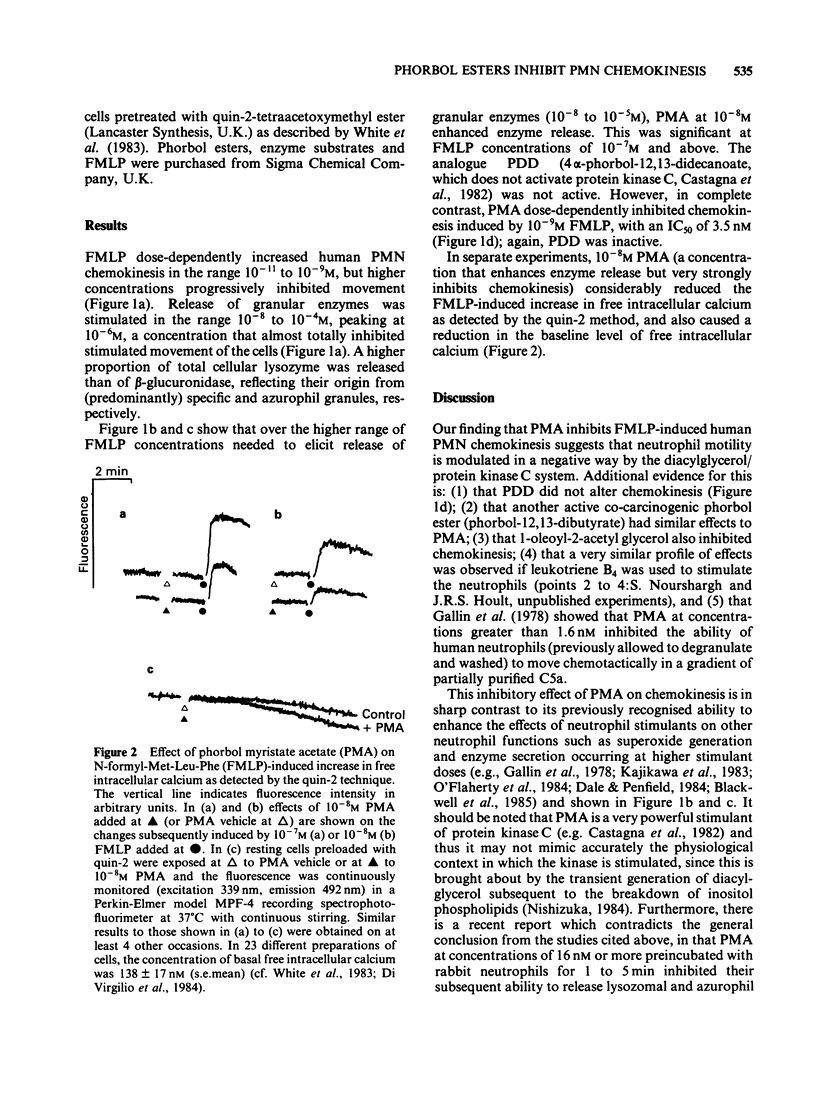Abstract
The effects of the co-carcinogenic phorbol ester, phorbol myristate acetate (PMA), on N-formyl-Met-Leu-Phe (FMLP)-induced human polymorphonuclear leukocyte chemokinesis and release of granular lysozyme and beta-glucuronidase were compared with those of the inactive phorbol didecanoate (PDD). Release of the enzymes was enhanced by PMA but was unaffected by PDD which also had no effect on chemokinesis. In contrast, FMLP-induced chemokinesis was completely suppressed by PMA in a dose-dependent fashion (ID50 = 3.5 nM). PMA also inhibited the FMLP-induced increase in cytoplasmic calcium level, measured by the fluorescent indicator quin-2. These and other results suggest that although the diacylglycerol/protein kinase C system is involved in the positive regulation of certain neutrophil functions (degranulation and superoxide generation), if it is very powerfully stimulated, as with PMA, it has inhibitory actions on other neutrophil properties such as motility.
Full text
PDF




Selected References
These references are in PubMed. This may not be the complete list of references from this article.
- Blackwell G. J., Bonser R. W., Dawson J., Garland L. G. Stimulation and inhibition of secretion by phorbol myristate acetate in different cell types. Biochem Biophys Res Commun. 1985 Mar 29;127(3):950–955. doi: 10.1016/s0006-291x(85)80036-x. [DOI] [PubMed] [Google Scholar]
- Castagna M., Takai Y., Kaibuchi K., Sano K., Kikkawa U., Nishizuka Y. Direct activation of calcium-activated, phospholipid-dependent protein kinase by tumor-promoting phorbol esters. J Biol Chem. 1982 Jul 10;257(13):7847–7851. [PubMed] [Google Scholar]
- Dale M. M., Penfield A. Synergism between phorbol ester and A23187 in superoxide production by neutrophils. FEBS Lett. 1984 Sep 17;175(1):170–172. doi: 10.1016/0014-5793(84)80592-x. [DOI] [PubMed] [Google Scholar]
- Di Virgilio F., Lew D. P., Pozzan T. Protein kinase C activation of physiological processes in human neutrophils at vanishingly small cytosolic Ca2+ levels. Nature. 1984 Aug 23;310(5979):691–693. doi: 10.1038/310691a0. [DOI] [PubMed] [Google Scholar]
- Dougherty R. W., Godfrey P. P., Hoyle P. C., Putney J. W., Jr, Freer R. J. Secretagogue-induced phosphoinositide metabolism in human leucocytes. Biochem J. 1984 Sep 1;222(2):307–314. doi: 10.1042/bj2220307. [DOI] [PMC free article] [PubMed] [Google Scholar]
- Gallin J. I., Wright D. G., Schiffmann E. Role of secretory events in modulating human neutrophil chemotaxis. J Clin Invest. 1978 Dec;62(6):1364–1374. doi: 10.1172/JCI109257. [DOI] [PMC free article] [PubMed] [Google Scholar]
- Kajikawa N., Kaibuchi K., Matsubara T., Kikkawa U., Takai Y., Nishizuka Y., Itoh K., Tomioka C. A possible role of protein kinase C in signal-induced lysosomal enzyme release. Biochem Biophys Res Commun. 1983 Oct 31;116(2):743–750. doi: 10.1016/0006-291x(83)90587-9. [DOI] [PubMed] [Google Scholar]
- Lagast H., Pozzan T., Waldvogel F. A., Lew P. D. Phorbol myristate acetate stimulates ATP-dependent calcium transport by the plasma membrane of neutrophils. J Clin Invest. 1984 Mar;73(3):878–883. doi: 10.1172/JCI111284. [DOI] [PMC free article] [PubMed] [Google Scholar]
- Naccache P. H., Molski T. F., Borgeat P., White J. R., Sha'afi R. I. Phorbol esters inhibit the fMet-Leu-Phe- and leukotriene B4-stimulated calcium mobilization and enzyme secretion in rabbit neutrophils. J Biol Chem. 1985 Feb 25;260(4):2125–2131. [PubMed] [Google Scholar]
- Nishizuka Y. The role of protein kinase C in cell surface signal transduction and tumour promotion. Nature. 1984 Apr 19;308(5961):693–698. doi: 10.1038/308693a0. [DOI] [PubMed] [Google Scholar]
- O'Flaherty J. T., Schmitt J. D., McCall C. E., Wykle R. L. Diacylglycerols enhance human neutrophil degranulation responses: relevancy to a multiple mediator hypothesis of cell function. Biochem Biophys Res Commun. 1984 Aug 30;123(1):64–70. doi: 10.1016/0006-291x(84)90380-2. [DOI] [PubMed] [Google Scholar]
- Sha'afi R. I., White J. R., Molski T. F., Shefcyk J., Volpi M., Naccache P. H., Feinstein M. B. Phorbol 12-myristate 13-acetate activates rabbit neutrophils without an apparent rise in the level of intracellular free calcium. Biochem Biophys Res Commun. 1983 Jul 29;114(2):638–645. doi: 10.1016/0006-291x(83)90828-8. [DOI] [PubMed] [Google Scholar]
- Smith M. J., Walker J. R. The effects of some antirheumatic drugs on an in vitro model of human polymorphonuclear leucocyte chemokinesis. Br J Pharmacol. 1980 Jul;69(3):473–478. doi: 10.1111/j.1476-5381.1980.tb07037.x. [DOI] [PMC free article] [PubMed] [Google Scholar]
- Southwick F. S., Stossel T. P. Contractile proteins in leukocyte function. Semin Hematol. 1983 Oct;20(4):305–321. [PubMed] [Google Scholar]
- White J. R., Huang C. K., Hill J. M., Jr, Naccache P. H., Becker E. L., Sha'afi R. I. Effect of phorbol 12-myristate 13-acetate and its analogue 4 alpha-phorbol 12,13-didecanoate on protein phosphorylation and lysosomal enzyme release in rabbit neutrophils. J Biol Chem. 1984 Jul 10;259(13):8605–8611. [PubMed] [Google Scholar]
- White J. R., Naccache P. H., Molski T. F., Borgeat P., Sha'afi R. I. Direct demonstration of increased intracellular concentration of free calcium in rabbit and human neutrophils following stimulation by chemotactic factor. Biochem Biophys Res Commun. 1983 May 31;113(1):44–50. doi: 10.1016/0006-291x(83)90429-1. [DOI] [PubMed] [Google Scholar]
- Yuli I., Tomonaga A., Synderman R. Chemoattractant receptor functions in human polymorphonuclear leukocytes are divergently altered by membrane fluidizers. Proc Natl Acad Sci U S A. 1982 Oct;79(19):5906–5910. doi: 10.1073/pnas.79.19.5906. [DOI] [PMC free article] [PubMed] [Google Scholar]


